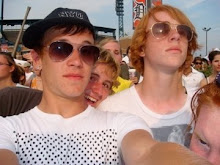 Looking back on our discussion about The Wolverton Bible (and particularly the enlightening video about its influence), I'm not sure there's much to say about R. Crumb's Book of Genesis besides the fact that it's a truthful, narrative take on the subject matter. As was mentioned, Crumb focuses on the personal and the intimate (in all meanings of the word), and less on the epic. In my opinion, this really speaks to his background in the underground comic scene, a movement that drew focus to the mundane, human aspect of life rarely presented in the funnybooks up until then. Wolverton, on the other hand, showed an initial focus on the grand and large-scale, which drew parallels with his illustration and editorial work, where he was tasked with conveying everything he needed to say in one image as opposed to relying on sequential art.
Looking back on our discussion about The Wolverton Bible (and particularly the enlightening video about its influence), I'm not sure there's much to say about R. Crumb's Book of Genesis besides the fact that it's a truthful, narrative take on the subject matter. As was mentioned, Crumb focuses on the personal and the intimate (in all meanings of the word), and less on the epic. In my opinion, this really speaks to his background in the underground comic scene, a movement that drew focus to the mundane, human aspect of life rarely presented in the funnybooks up until then. Wolverton, on the other hand, showed an initial focus on the grand and large-scale, which drew parallels with his illustration and editorial work, where he was tasked with conveying everything he needed to say in one image as opposed to relying on sequential art.Of course, with Crumb's assertion that he took it on as a "straight illustration job," there's still room for interpretation. One of the tasks of a comic artist is selecting the extremely specific moment to convey (especially in the case of an artist like Crumb, whose work relies less on the illusion of movement, in my opinion, and more on the static scene). Within the selection of that moment comes the selection of the staging and framing, all of which hold countless variables for the artist. So when Crumb chooses to depict a sex scene from Genesis, his crafting of that scene is very much intentional and very much his own.

As with Wolverton, strangely enough, some of my favorite scenes come from the very beginning. This probably isn't too difficult to justify: I have little familiarity with the Bible, and it is at it's most visually stimulating when it is farthest from reality. The Garden of Eden and the great flood (along with Wolverton's Revelations) are scenes that are impossible to see in real life, and so I was always drawn to them more than the scenes of Isrealite conflict, something still to true.
The scene of Adam and Eve crouching in hiding away from God is a perfect example of Crumb's style reaching confluence with the original text. He chooses a scene laden with sexuality and shame and complex human emotion from a rather rote Biblical telling, and it feels more Crumb than King James. It's also a scene that wouldn't have appeared nearly the same under Wolverton's pen.
Similarly, the anthropomorphized serpent in the Garden feels very unique to this telling. Crumb has a rich history of bipedal, talking animals, and having the serpent appear so odd and out-of-place helps bring that history to the surface while also highlighting the other-worldliness of the tale.

It seems bizarre that Crumb has so few long-form work to point to when discussing his oeuvre. Unless I'm mistaken, this is his longest release, which feels a bit like an iconic punk band releasing countless singles and b-sides and then a full-length gospel album.
At any rate, it's not going to be less controversial any time soon. Those unawares should check out what an outspoken Australian had to say about Crumb, and the effect it had. I'd also urge anyone who's seen the film Crumb to follow up a bit on his family, particularly his brother Maxon, whose work I'd love to purchase as easily as the better known Crumb brother's.

A slightly racier look at Adam and Eve from earlier in Crumb's career.

No comments:
Post a Comment